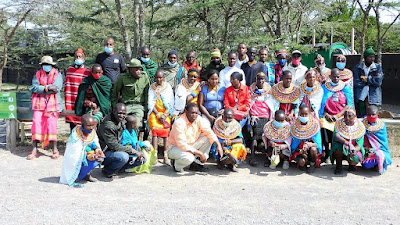Road Trip
 |
| Credit: Paul Naiputuri |
On Friday, a second set of people from Loisaba and the communities went to Ol Pejeta to talk about the implications of having rhino at Loisaba. Tom intends to set aside 25,000 acres for the rhino to begin with and see how it goes from there.
 |
| Credit: Mohammed Iribo |
Once again, the visitors were able to see the rhino in their natural habitat and to hear about the differences between the black and so-called white rhino. In fact all rhino are the same colour and the word 'white' is thought to be a mis-pronounciation of the word 'wide' which referred to the width of the rhinos mouth. The shorter, black rhinos have a narrower mouth and prefer to browse, whereas the white/wide rhinos - The Northern and The Southern - have wider mouths and prefer to graze. It is black rhinos which will be hopefully coming to Loisaba.
The number of black rhinos diminished by over 95% from 1960 to the 1990's and they are listed as critically endangered. They were hunted by the early settlers and then demand switched to Asia and the Middle East where rhino horn is falsely believed to have medicinal properties; rhino horn is made from the same substance - keratin - as human finger nails.
 |
| Credit: Mohamed Iribo |
In 1993 there were just 2,300 left in the world but thanks to conservation such as that by Ol Pejeta there are now 5,000 - 140 in Ol Pejeta alone. Sadly, the Northern White Rhino is almost extinct with the last two remaining females at Ol Pejeta. Sudan, the last remaining male and three female White Rhinos were brought 'home' from a zoo in the Czech Republic in the hope that he would successfully mate with them and the ones already at Ol Pejeta, but these efforts were unsuccessful and Sudan died in 2018; the only hope now is that extremely expensive in vitro fertilisation and stem cell technology will be developed to save the day. Funds are being raised by Ol Pejeta to enable this to happen. #Makearhino
 |
| Credit: Mohamed Iribo |
The Southern White Rhino has been brought back from the brink, a world population of just 20-50 in South Africa now totalling over 20,000 in East and South Africa - it can be done. Ol Pejeta has 30. There is still a high demand for their horn meaning that protection and security is needed constantly.
Tom and Loisaba Conservancy cannot wait to make a contribution to the conservation of the rhino and it was essential that members of the community were on board with the project. Thanks to Paul, and the staff at Ol Pejeta, they have been greatly reassured about their future with the rhino. The black rhino will be located in the more rugged areas of Loisaba where there are lots of shrubs.
 |
| Credit: Paul Naiputari |
The visitors also saw the chimpanzees at a distance...
...and admired this design for a cattle-boma which is easy to move and less destructive to the trees than a traditional, thorn boma. It also causes less injuries and infections to the stock kept inside.
 |
| Credit: Paul Naiputari |
Much of the information provided here is taken from Ol Pejeta Conservancy website and we would like to thank them very much for their help in every respect.


Comments
Post a Comment